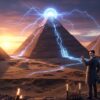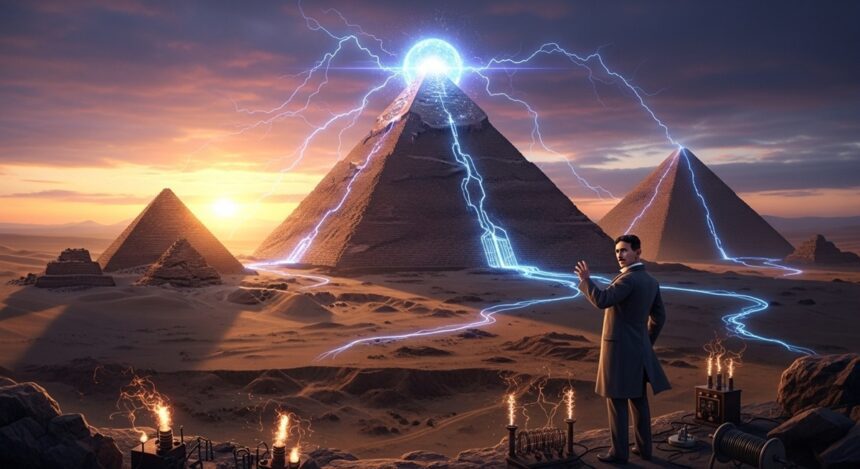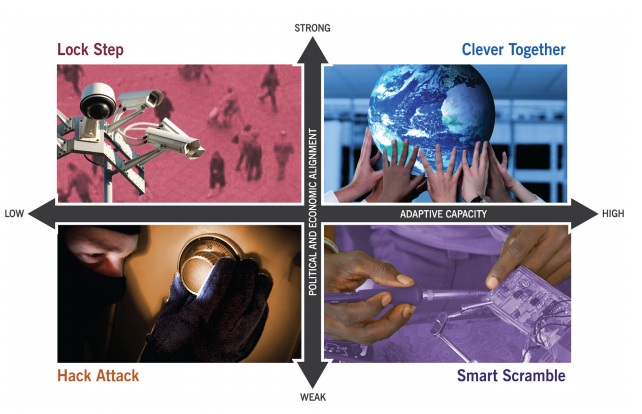Have you ever stood in awe of the Great Pyramids of Giza, wondering how such colossal structures could have been built thousands of years ago? For centuries, we’ve been told they were grand tombs for pharaohs, symbols of eternal life and royal power. But what if that story is just a fraction of the truth? What if these pyramids were sophisticated machines designed to harness and transmit energy wirelessly across vast distances?
This isn’t some wild conspiracy spun from thin air. It’s a theory that transcends through history, championed by none other than Nikola Tesla, the visionary inventor who revolutionized modern electricity.
The Never Ending Enigma of the Egyptian Pyramids
The pyramids of Giza have puzzled historians, archaeologists, and scientists for generations. Rising from the desert sands like timeless guardians, these structures defy easy explanation. Built around 4,500 years ago, the Great Pyramid alone consists of over 2 million stone blocks, some weighing as much as 80 tons. How did ancient Egyptians, with supposedly primitive tools, achieve such precision? Alignments with celestial bodies, mathematical ratios like pi and the golden mean embedded in their design—these aren’t coincidences. They’re clues pointing to a deeper purpose.
Traditional Egyptology insists they were tombs. Yet, no mummies have ever been found in the main pyramids, and the internal chambers seem oddly functional rather than ceremonial. Ventilation shafts, precise corridors, and granite-lined rooms suggest engineering far beyond mere grave-digging. Over the years, alternative theories have emerged, proposing the pyramids as astronomical observatories, water pumps, or even acoustic resonators. But one idea stands out for its blend of ancient mystery and modern science: the pyramids as power plants.
Challenging the Tomb Narrative: Signs of Advanced Technology
Let’s start by debunking the tomb myth. Official accounts claim the pyramids were constructed using ramps, levers, and sheer manpower. But evidence suggests otherwise. Core samples from the stones reveal traces of chemical reactions, hinting at possible geopolymer concrete—man-made rock that could explain the seamless fits. The absence of hieroglyphs detailing construction in the pyramids themselves is suspicious; most “evidence” comes from later additions or external sources.
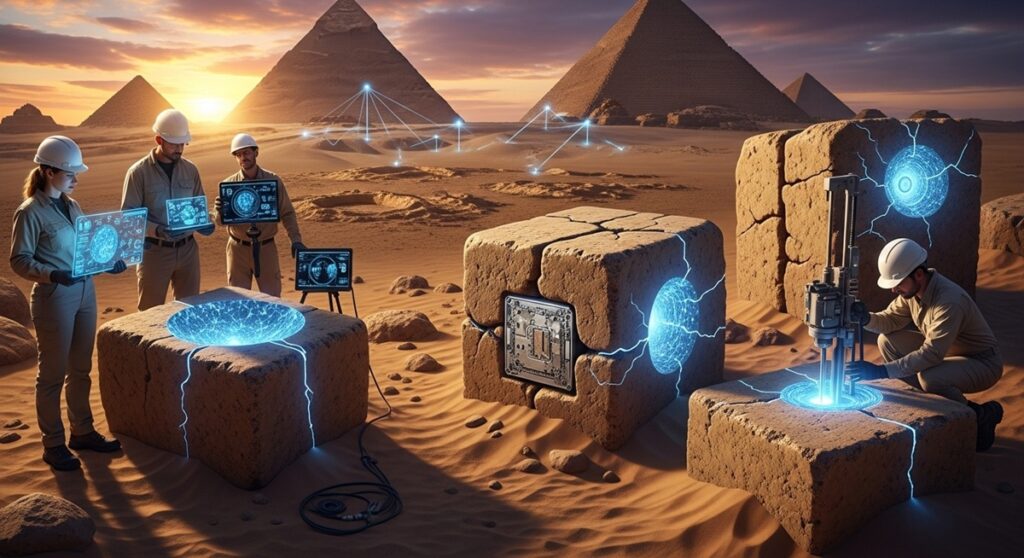
Moreover, the pyramids’ orientation to true north is accurate to within a fraction of a degree, something modern builders struggle with without advanced tools. Their bases cover areas the size of several football fields, yet the sides are level to within inches. These feats scream high technology, not bronze-age brute force. Independent researchers argue that the Egyptians inherited these structures from an even older civilization, repurposing them as best they could. After all, why build such energy-intensive monuments just for dead kings when survival in a harsh desert demanded innovation?
As we peel back layers of history, patterns emerge. Floods of the Nile, underground aquifers, and the pyramids’ proximity to water sources could have played a role in energy generation. Vibrations from flowing water, combined with the stones’ properties, might have created electricity. It’s a theory that’s gaining traction, especially when linked to Tesla’s ideas.
Nikola Tesla’s Obsession with the Pyramids
Nikola Tesla, the eccentric genius born in 1856, isn’t just the father of alternating current (AC) electricity—he’s a bridge between ancient wonders and futuristic tech. With over 300 patents to his name (though many were stolen or suppressed), Tesla dreamed of free, wireless energy for all humanity. His Wardenclyffe Tower in New York, built in the early 1900s, aimed to transmit power without wires, drawing from Earth’s natural frequencies. Funding dried up, thanks to rivals like Edison and J.P. Morgan, but Tesla’s vision persisted.
What many don’t know is Tesla’s deep fascination with the Egyptian pyramids. He studied them extensively, believing they held the key to unlimited energy. In interviews and notes, Tesla referenced the pyramids as “giant transmitters” that could harness Earth’s ionosphere and geomagnetic fields. He even designed his towers with pyramid-like proportions, convinced the shape amplified energy waves.
Tesla’s Groundbreaking Innovations in Wireless Energy
To understand Tesla’s pyramid theory, we need to grasp his work on wireless transmission. Tesla demonstrated wireless lighting in the 1890s, powering bulbs from afar using electromagnetic fields. His Tesla Coil, a resonant transformer, created high-voltage, low-current electricity that could arc through the air. He envisioned a global network where energy bounced off the atmosphere, accessible anywhere.
But Tesla went further, tapping into “scalar waves” or longitudinal waves—non-Hertzian energy forms that travel faster than light without losing power. These ideas, dismissed as pseudoscience then, are now explored in quantum physics. Tesla claimed the pyramids used similar principles, focusing energy through their geometry. The apex, he theorized, concentrated power for broadcast, much like his towers.
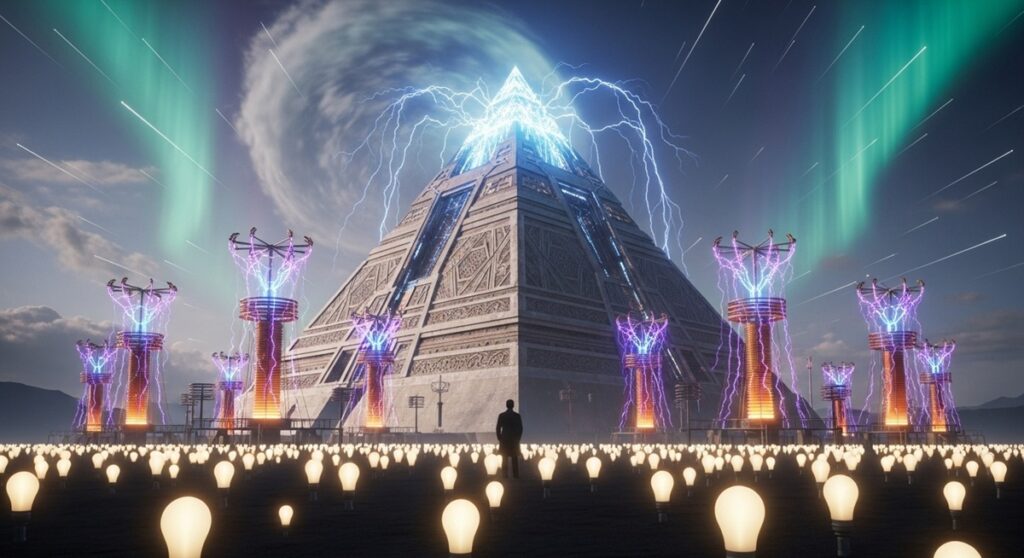
In one rare quote, Tesla reportedly said the pyramids were “energy generators, capable of producing free, limitless energy.” He pointed to their quartz-rich granite interiors, which could vibrate and produce piezoelectricity—electricity from mechanical stress. Tesla’s experiments in Colorado Springs, where he lit 200 lamps wirelessly over 25 miles, mirrored what he believed the ancients achieved on a grander scale.
Tesla’s Direct Insights on the Pyramids as Power Stations
Tesla wasn’t alone in his views. He drew inspiration from Egypt’s obelisks and pyramids during his travels and studies. According to biographers, he calculated the Great Pyramid’s dimensions and found resonances matching Earth’s Schumann frequency, about 7.83 Hz, the planet’s “heartbeat.” This alignment, Tesla argued, allowed the pyramid to act as a resonator, pulling energy from seismic activity or atmospheric charges.
Imagine it: Underground chambers channeling water to create pressure, vibrating granite blocks to generate current, then beaming it wirelessly via the pyramidion at the top. Tesla saw parallels in his own failures, Wardenclyffe was sabotaged because free energy threatened profits. Similarly, he suspected ancient knowledge was hidden or destroyed by elites. Today, companies like Emrod in New Zealand test wireless power grids, proving Tesla’s concepts viable. If he was right about that, why not the pyramids?
The Crucial Role of Pyramidions and Sacred Materials
At the heart of the power plant theory lies the pyramidion, the capstone that once crowned each pyramid. These weren’t decorative; they were functional apexes, designed to focus and radiate energy. Historical records describe them as pyramidal stones, often made of polished granite or limestone, gleaming under the sun.
But here’s where it gets intriguing: Many pyramidions were coated in precious metals. Official sources mention copper, but ancient texts hint at electrum, an alloy of gold and silver. This coating wasn’t just for show; it could conduct and amplify electrical fields, turning the pyramid into a massive antenna.
Granite’s Hidden Piezoelectric Properties
Granite, the pyramids’ inner core material, is no ordinary rock. Rich in quartz crystals, it exhibits piezoelectricity—generating voltage under pressure. In the King’s Chamber of the Great Pyramid, five layers of granite beams weigh hundreds of tons, potentially compressing the quartz below.
Modern science confirms this: Quartz oscillators power watches and electronics. In pyramids, natural vibrations from Earth’s movements or Nile floods could stress the granite, producing electricity. Researchers like Christopher Dunn, in his book “The Giza Power Plant,” propose the chambers acted as acoustic resonators, amplifying sounds to enhance piezoelectric output. The sarcophagus, also granite, might have been a reaction vessel, mixing chemicals to boost energy.
Experiments show granite under stress emits electromagnetic waves. Scaled models of pyramids have even concentrated radio signals at their apexes. If the ancients knew this, the pyramids could have powered an entire civilization—lighting homes, running machines, all wirelessly.
Electrum: The Alloy Linking Amber, Electrons, and Ancient Energy
Electrum’s story is a linguistic and scientific treasure. Derived from the Greek “elektron,” meaning amber, it shares roots with “electricity” and “electron.” Amber’s electrostatic properties—rubbing it generates static charge—mirrored electrum’s pale yellow hue, but the connection runs deeper.
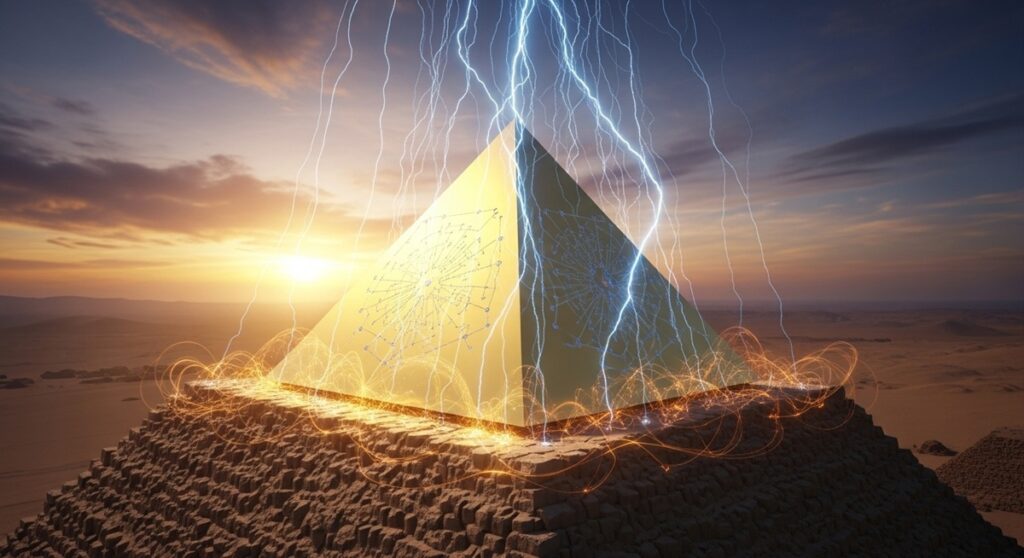
In ancient Egypt, electrum coated pyramidions and obelisks, reflecting sunlight while possibly conducting energy. As an alloy (typically 20-80% gold, rest silver), it’s more conductive than pure gold and resistant to corrosion. This durability made it ideal for withstanding the harsh desert environment while maintaining its conductive properties over centuries. The use of electrum in pyramidions wasn’t merely aesthetic; it likely served a functional role, acting as a conductor or capacitor to channel and amplify the energy generated within the pyramid’s structure. Imagine the pyramidion, gleaming under the Egyptian sun, not just as a decorative cap but as a critical component in a sophisticated energy system, broadcasting power across vast distances.
The Linguistic Clue: Electrum and Electrostatic Power
The etymology of “electrum” offers a tantalizing hint about its purpose. The Greek word ἤλεκτρον (ēlektron) originally referred to amber, a material known since antiquity for its ability to generate static electricity when rubbed. This property fascinated early philosophers, who observed sparks and attraction in amber, laying the groundwork for our modern understanding of electricity. The same term was applied to the gold-silver alloy due to its similar pale, amber-like sheen. But could this naming reflect a deeper understanding of electrum’s electrostatic or conductive capabilities?
In ancient texts, including references in Homer’s Odyssey, electrum is described as a prized material, often associated with divine or sacred objects. Its use in pyramidions and obelisks suggests the ancients recognized its unique properties. Modern science confirms that gold-silver alloys can enhance conductivity and resist tarnishing, making electrum a perfect candidate for energy transmission. If the pyramidions were coated in electrum, they could have acted as antennas, capturing and radiating the electrical energy produced by the pyramid’s internal mechanisms, much like Tesla’s Wardenclyffe Tower aimed to do in the early 20th century.
Rewriting History: The Pyramids as Relics of a Lost Civilization
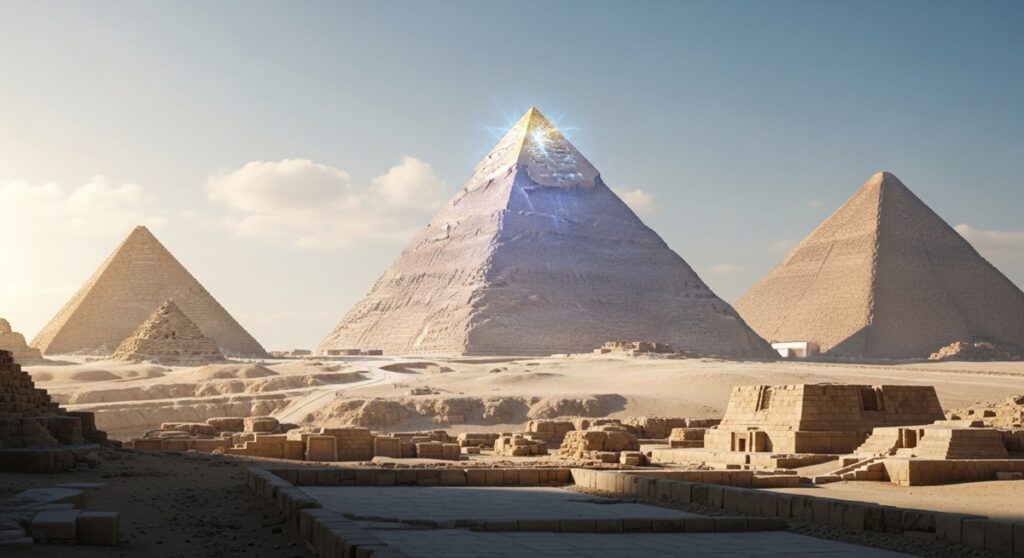
Tesla’s belief that the pyramids were not built by the Egyptians but inherited from a more advanced, pre-dynastic civilization aligns with growing evidence of a “golden age” society. This idea challenges the mainstream narrative that the pyramids were solely the work of pharaohs like Khufu. Geological studies, such as erosion patterns on the Sphinx, suggest water damage dating back over 10,000 years, long before dynastic Egypt. This points to a much older origin, possibly from a civilization wiped out by cataclysmic events like floods or pole shifts.
Hidden Truths and Historical Cover-Ups
Why would such advanced technology be buried in the sands of time? Some researchers argue that historical records were deliberately altered to obscure the pyramids’ true purpose. The outer limestone casing of the Great Pyramid, now largely gone, may have been added later to disguise the structure’s original form, making it appear as a tomb. Hieroglyphs found inside, often cited as evidence of Egyptian construction, could have been later additions, etched to claim credit for inherited marvels.
Skeptics of the power plant theory often point to the lack of direct evidence, like ancient wires or machines. But wireless energy, as Tesla demonstrated, requires no such infrastructure. The pyramid’s internal chambers, with their precise alignments and resonant properties, could have harnessed natural forces—seismic vibrations, water flow, or atmospheric electricity—to generate power. The electrum-coated pyramidion would then broadcast this energy to receivers, such as obelisks or other structures, forming a grid that powered an advanced society.
Modern Parallels: Rediscovering Ancient Technology
Today, as wireless charging becomes commonplace for phones and electric vehicles, Tesla’s vision feels prophetic. Companies like Emrod in New Zealand are testing long-range wireless power transmission, echoing the principles Tesla championed and the pyramids may have embodied. These modern experiments use microwave beams to send electricity, but the ancients might have used scalar waves or other non-Hertzian methods, as Tesla explored in his later years. If a civilization thousands of years ago mastered such technology, it would explain myths of a “golden age” where energy was abundant and freely accessible.
Independent researchers, like engineer Christopher Dunn, author of The Giza Power Plant, have tested scale models of the pyramids, detecting measurable electromagnetic activity. In 2018, physicists discovered that the Great Pyramid focuses electromagnetic energy within its chambers under specific wavelengths, supporting the idea of a functional design. Acoustic studies further reveal that the King’s Chamber resonates at frequencies matching the human voice or Earth’s natural vibrations, potentially amplifying energy output.
Confronting the Skeptics: Why the Truth Matters
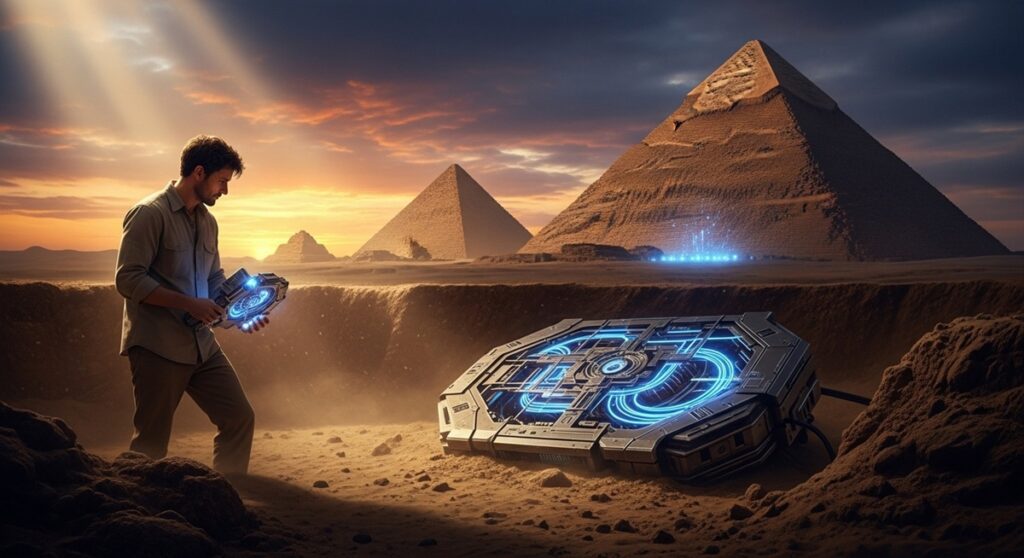
Critics dismiss the power plant theory as pseudoscience, clinging to the tomb narrative despite its inconsistencies. Some even propose that the pyramids were built in the last 200-250 years by modern conspirators to fake ancient history, a claim that ignores overwhelming archaeological evidence like radiocarbon dating and quarry marks. These distractions, often spread by those with agendas, aim to muddy the waters and discourage inquiry into the pyramids’ true origins.
But the truth matters. If the pyramids were power plants, they represent a lost chapter of human ingenuity, a testament to what we’re capable of when knowledge isn’t suppressed. Tesla faced similar resistance, his free-energy projects were defunded, his patents buried, because they threatened entrenched powers. The parallels are striking: just as Tesla’s ideas were dismissed as “impossible,” the pyramids’ technological purpose has been buried under the weight of dogma.
A Call to Question and Explore
The evidence is mounting. From granite’s piezoelectric properties to electrum’s conductivity, from the pyramids’ precise alignments to Tesla’s own experiments, the pieces form a compelling picture. The Great Pyramids of Giza may have been the beating heart of an ancient energy grid, powering a civilization we’ve only begun to understand. By questioning official narratives and embracing interdisciplinary research, combining archaeology, physics, and engineering—we can reclaim this lost knowledge.
Nikola Tesla’s legacy urges us to think boldly. He saw the pyramids not as relics of a primitive past but as blueprints for a sustainable future. As we face energy crises today, the pyramids’ secrets could inspire solutions—clean, limitless power for all. The next time you gaze at these ancient wonders, ask yourself: Are they silent tombs, or are they whispering the secrets of a forgotten world, waiting for us to listen?


